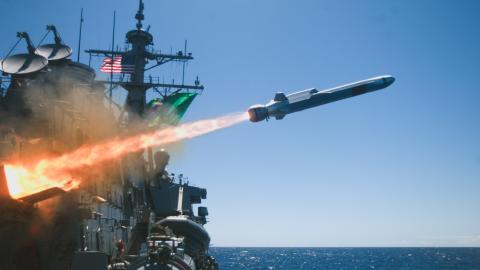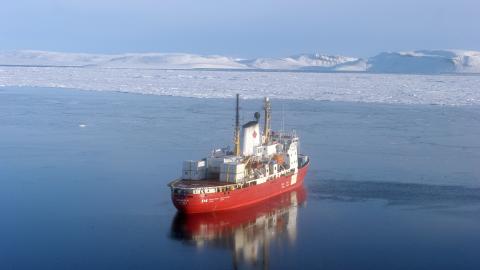Russian state-owned nuclear energy corporation Rosatom and Chinese shipping company Hainan Yangpu NewNew Shipping announced in 2024 that they would cooperate on operating an all-year-round container shipping route through the Arctic. Since then, shipping interruptions at flashpoints from the Panama Canal to the Red Sea have thrown the global economy into turmoil. Worse, increasing military and technological collaboration between Beijing and Moscow has escalated the security threats facing the United States and its allies.
To counter this cooperation, the United States should consider working with its Canadian allies to open and maintain an equivalent shipping route — an “Ice Canal” across the Northwest Passage — to bolster their commercial and strategic presence in the region.
All-year-round shipping through the Arctic would require significant infrastructure and promises high costs for fuel, equipment, and manpower. But these investments would generate considerable economic returns. The Northwest Passage can reduce shipping distance between London and Tokyo by about 3,780 nautical miles, or approximately 7,000 kilometers. And the priceless strategic benefits of bolstering U.S. and allied nuclear security should incentivize public cooperation with the private sector, defraying costs further.
Moscow and Beijing recognize the region’s significance. Their agreement involves building five ice-class container ships and investing in infrastructure such as deep-water ports and refueling and repair facilities along the Northern Sea Route along Russia’s Arctic coastline. These container ships are dual-use, meaning they can be used for commercial purposes and military sealift operations such as weapons systems and troop transport. The initiative signals that Russia and China prioritize regional mobility, allowing them to cooperate on increasing the profitability of Russia’s Arctic coastline and on strategic interoperability across the region.
A competing dual-use project, led by the U.S. and Canada, would help engage Japan, South Korea, and other Arctic NATO allies in strategic and economic cooperation across the region.
The first step to opening this route is to find out what we do not know. Because very few people have been to the Northwest Passage in winter, assessments are largely based on theoretical models and historical and satellite data. These means of data collection are insufficient to create a reliable and detailed map of the geographical and seasonal shipping challenges. Shipping along the Northwest Passage will require initial efforts to map sea ice movements and wind patterns throughout the year.
Canada has 20 vessels in its icebreaker fleet, two of which are heavy icebreakers. These are expected to be replaced with two new polar vessels capable of operating in moderate multiyear ice conditions in 2030. To complement research, approximately five years of all-year-round icebreaker presence is needed to map the geographical locations and timing of choke points created by multiyear ice and wind patterns.
The data collected by the icebreaker presence will be used to identify locations for deploying unmanned aerial vehicles or helicopters supplying ice and weather data to vessels and aircraft transiting the Northwest Passage. Icebreakers will be on call all year round to assist vessels transiting ice choke points. This would allow for safe all-year-round passage of container ships and give U.S. and Canadian forces invaluable real-world experience operating jointly and across domains in Arctic conditions.
Additionally, a permanent Western presence along the Northwest Passage would give U.S. and allied militaries invaluable situational awareness and the ability to respond swiftly to the outbreak of conflict in critical strategic areas. This is particularly important because the shortest routes for Russian intercontinental ballistic missiles are through the poorly surveilled airspace north of the Arctic Circle.
In the Atlantic, the Greenland–Iceland–United Kingdom gap and the Barents Sea are the primary strategic locations for Russian nuclear-armed ballistic missile submarines. Insufficient underwater surveillance in these areas, as well as the Bear Gap between Norwegian Svalbard and Scandinavia and along Greenland’s east coast, allows Russian SSBNs more freedom to operate undetected, strengthening Russia’s second-strike capability toward North America and therefore weakening U.S. deterrence.
On the eastern end of the supercontinent, the Bering Strait — the entrance to the Pacific between Russia and Alaska — has become a critical chokepoint. Russia has fitted submarine bases near its eastern port city of Vladivostok with hardened shelter pens and additional repair and maintenance facilities to avoid dependency on Barents Sea facilities. Russian-Chinese base-sharing arrangements at the entrance to the North Pacific strengthen interoperability. And Beijing and Moscow have signaled their willingness to extend cooperation to their strategic nuclear forces with a joint air patrol with four nuclear-capable bombers in Alaska’s air defense identification zone.
CHINA ANGLING FOR ‘INCREASED ENGAGEMENT WITH GREENLAND,’ INTEL COMMUNITY SAYS
A container route along the Northwest Passage would do much to establish presence, connectivity, and interoperability between Canada, the U.S., and other allies with Arctic interests and represent an important countermove to Russia-China collaboration. Canadian leadership in establishing and operating the new container route is advisable to avoid ramping up international tensions, thanks to its rights and responsibilities as a coastal state.
As Moscow and Beijing prepare for dual-use operations from the Barents Sea to the Bering Strait, it is imperative for purposes of deterrence and situational awareness to establish an all-year-round North American strategic presence from the North Atlantic to the North Pacific. The Northwest Passage offers an opportunity to demonstrate North American leadership by collaborating with allies, commercial actors, and local communities to promote a prosperous and secure Arctic region.




















